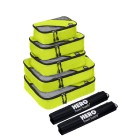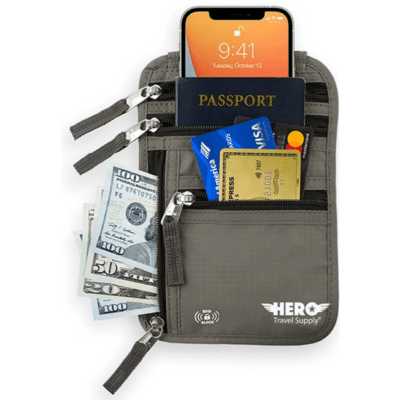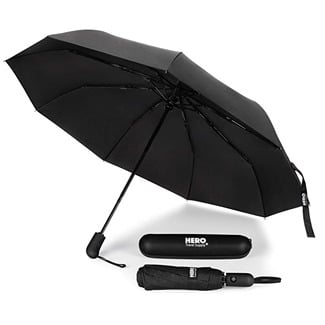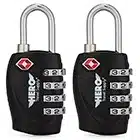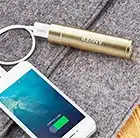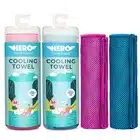When I think about Haiti, I think about the warm, tropical weather, plantains, unmatched mangoes, and kind and friendly locals. If you’re planning to travel to Haiti and wondering if you’re electronics will be compatible with Haiti’s plugs, we’ve put together a guide to Haiti’s outlets and electricity so you can go prepared. We also included a packing list for Haiti and FAQs about traveling to Haiti so you can travel confidently and well-prepared!
US to Haiti Power Adapter: What Plug Do I Need? (2025)
Which power outlets do they use in Haiti?
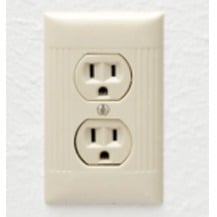
In Haiti, the power plugs and sockets are type A and B.
- Type A sockets are ungrounded plugs with two flat parallel prongs, which is standard for most of North and Central America.
- Type B is similar but also has a U-shaped pin, which grounds the device. Type B’s socket also works with plug A.
The standard voltage in Haiti is 110 V and the standard frequency is 60 Hz. The US has a standard voltage range of 110-120 V.
What kind of adapter do I need for Haiti?
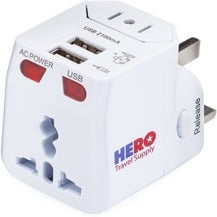
While you’re getting everything ready for your trip, you’ll likely wonder, “What plug do I need in Haiti?” You’ll need the same plugs as you do in the US, Type A and Type B. Therefore, you technically don’t need a power plug adapter when coming from the US to Haiti.
However, with Haiti’s limited and unpredictable electricity, it’s smart to pack a power adapter with a built-in fuse, like this universal adapter. This can help protect your appliances in case there are any unpredictable electrical surges in Haiti, where there isn’t the most reliable power supply. This universal adapter is also a great travel item to own because it works in 100+ worldwide, comes with a lifetime guarantee, and has two USB ports. It’s one of the most versatile travel items you can pack.
What’s the electricity and power supply like in Haiti?
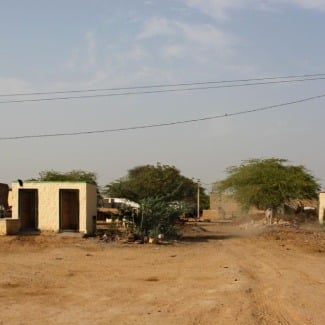
Do I need a voltage converter for Haiti?
In Haiti, the standard voltage is 110 V and the frequency is 60 Hz. The standard voltage in the US is 120 V. So, you can generally use your electric appliances in Haiti without a voltage converter. However, it’s a good idea to double-check the appliance and see the accepted range, i.e., if the label on your laptop says, “Input: 100-240 V, 50/60 Hz”, then you’re ok to use your device without a voltage converter.
Most electronics like laptops, computers, phones, and tablets are dual voltage, so a converter is unnecessary. However, if you plan on bringing high-power electronics such as hair dryers or straighteners, then you’ll need a converter because they usually are not dual voltage. Either way, it’s always important to check the labels on your devices to see if they are compatible with Hait’s voltage and frequency. You don’t want to risk frying your electronics or damaging the hotel’s power outlets.
Other Haiti Packing List Items
In addition to your US to Haiti power adapter, these items will help you pack with intention and expand the possibilities of your getaway. Also, check out our Haiti packing list for more inspiration and ideas.
-
1. Packing Cubes
I never travel without packing cubes anymore. Whether you’re hoping to keep your t-shirts, separate from your socks or quickly organize the spare outfit you’re bringing in your carry-on, packing cubes help keep travel a lot simpler. With three different sizes and two included laundry bags, packing for Haiti just got easier.
![Packing Cubes]()
-
2. Electrolyte Powder
Between hot, humid summer days and needing to make sure your water is safe to drink, it’s easy to get dehydrated in Haiti. These on-the-go electrolyte powder packets are full of vitamins like B12, B3, and Vitamin C, hydrating faster than water alone. Have these on hand for yourself and for those around you.
![Electrolyte Powder]()
-
3. Virtual Private Network (VPN)
Virtual Private Networks, or VPNs, keep your data on public wi-fi safe by providing another layer of security. Whether you unexpectedly need to pay a bill, or want to stream your favorite TV show, a secure, strong VPN is the way to go. If you’re using wi-fi from an airport, hotel, or Airbnb, it’s smart to set up a VPN before traveling to Haiti.
![vpn]()
-
4. Neck Wallet
It’s a good idea to pack a neck wallet, whether you’re looking for one with multi-RFID layers that shield your credit cards and passport from potential e-theft or just want to protect against pickpockets. With a resilient and durable design, a lifetime replacement guarantee, and streamlined accessibility, HERO’s got you covered.
![Neck Wallet]()
-
5. Windproof Travel Umbrella
Haiti has two rainy seasons, one from April to June and one from August to mid-November. If you’re traveling to Haiti during a rainy season, you’ll want to pack a compact, lightweight travel umbrella. Given the strength of Haiti’s first rainy season and its wind gusts, you’ll also appreciate the advanced windproof protection.
![Windproof Travel Umbrella]()
-
6. LifeStraw Water Bottle
With Haiti’s limited access to clean water, you’ll need to filter all of your drinking water, and LifeStraw’s water bottle is perfect for staying cool during hot summers in Haiti. You can also combine LifeStraw’s filter with purification tablets (a good idea with the recent cholera outbreak). With both a microfiltration membrane and activated carbon filter, LifeStraw is rigorously tested and great for sustainability.
![LifeStraw Water Bottle]()
-
7. TSA-Approved Luggage Locks
Luggage locks are an easy way to keep your luggage secure while you’re traveling. TSA accepted and available in a two-pack. You’ve got one for your checked bag and one for your carry-on (how many people have ever dozed off in an airport?). These luggage locks are also compact size, and the 4-digit lock allows for 10,000 unique combinations.
![luggage locks]()
-
8. Lipstick-sized Portable Charger
Since access to electricity is limited in Haiti, it’s smart to bring a portable charger with you during the day. Especially if you’re traveling to a rural area, there’s no guarantee you will be able to charge your electronic devices. If you’re looking for a compact, lipstick-size charger with 5,000 mAh of power (enough to charge your phone 1x or 2x, depending), look no further.
![Lipstick-sized Portable Charger]()
-
9. Cooling Towel
-
10. Travel Insurance for Haiti
It’s always a good idea to purchase travel insurance, as an infinite number of things could always go wrong. Whether you’re looking for plans that cover lost or stolen luggage, flight cancellations, or medical expenses, Travelinsurance.com offers excellent, unbeatable selection and comparisons so that you can find the travel insurance plan that’s right for you.
![Travel Insurance for Haiti]()
-
11. Daypack
Whether you plan to hike in Haiti or are looking for a lightweight, durable daypack bag for humanitarian work, Venture Pal is a trusted and highly rated brand. With a waterproof pocket, an option to fold the backpack into its own pocket in your suitcase, and 40 L of storage space, this daypack has unique features that make it great for your travels to Haiti.
![Daypack]()
FAQs about Traveling in Haiti
-
1. What’s the weather like in Haiti?
![What’s the weather like in Haiti?]()
Haiti is a tropical island with warm, humid weather. Typically, the temperature ranges from 73℉ to 94℉ throughout the year, so you don’t need to bring any cold-weather clothes. There are two rainy seasons in Haiti, one from April to June and one from August to mid-November. If you’re traveling to Haiti in the summer, you’ll want to anticipate mosquitos, heat, and humidity.
-
2. What languages are spoken in Haiti?
The two official languages spoken in Haiti are Haitian Creole and French. Creole is the most commonly spoken language in Haiti, and there are a lot of online resources to learn common phrases. Personally, I would recommend learning Creole over French, as French is tied up with class and colonialism.
-
3. What time of year should I travel to Haiti?
![What time of year should I travel to Haiti?]()
Haiti’s dry season is from November to March, which with lower humidity and less rainy days, is the best time for snorkeling, hiking, and other outdoor activities. Dry season is also peak travel season, so keep that in mind. It just depends on your itinerary and budget. I traveled to Haiti in the summer, and it was very hot. You get used to sweating with the temperatures, hot summer sun, and the humidity. It’s vital to stay hydrated and bring as much quick-dry clothing as possible.
-
4. Is it safe to drink the tap water in Haiti?
It’s not safe to drink tap water in Haiti. Make sure to treat and/or filter your water (purification tablets and LifeStraw’s filter are great), or buy bottled water if you’re out somewhere without a way to filter tap water.
When I was in Haiti, we treated our water 100% of the time with purification tablets. It’s also good to keep in mind that a huge percentage of locals don’t have access to clean water, so asking your hosts if it would be beneficial to bring additional purification tablets or LifeStraw filters to support the community is a good idea.
-
5. Is it safe to travel to Haiti?
![Is it safe to travel to Haiti?]()
It’s always a good idea to talk to locals and check travel advisory alerts for the area and time you’re planning to travel to Haiti. Generally, I’ve found that locals give the best advice (we each know our own country best), and can offer insight. If you find it’s a less than optimal time to travel to Haiti, or are looking for insight for your upcoming trip, visithaiti.com is a great resource.




